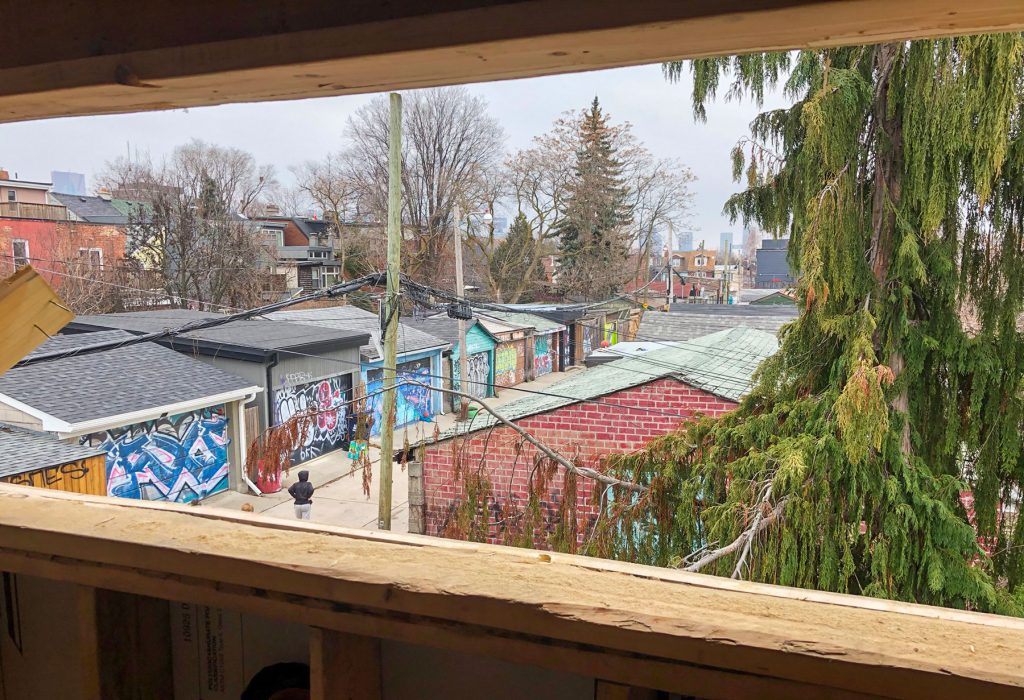Croft Street showcases laneway homes and “green” potential

COURTESY ALAR KONGATS
By Luca Tatulli
A few blocks east of Bathurst Street running north from College Street, you find Croft Street, which is in fact an alleyway. At the gateway to the laneway on College, there is a colourful mural dedicated to the street’s namesake, John Croft. With murals on most of the garage doors and creative pot planters, one could be forgiven for thinking that the laneway itself is a canvas. There are currently two laneway homes on Croft Street, both of which stand out for their uniqueness and contrast to the Victorian character of the neighbourhood. A third laneway home at 92 Croft St. is under construction. It too, will stand out – not only for its design, but for features which put it on the cutting-edge of environmental sustainability.
The new home will have 1230 square feet of floor space and its exterior will be covered with locally sourced pine and heron-blue steel mirroring the older cottages that used to line the alleyway at a time when it was known as Ulster Lane. It will also share a lush garden with its neighbours.
The home’s roof will be almost entirely covered with solar panels, and they will generate an estimated 93 percent of the home’s electricity needs. The home will be powered only by electricity, with no use of natural gas.
Inside, the temperature will be regulated by a ductless heating and cooling system. This is expected to cut costs significantly by transferring heat instead of simply generating it. According to Energy Star modelling, this form of heating will cut energy consumption by up to 60 percent.
A smart monitor sump pump system will protect the home from floods caused by rising water levels.
“Sustainability runs deep. It’s not just about the materials being used and the energy being generated but the longevity of the build itself,” says Zeke Kaplan, president of ZZ Contracting, the builders of the home. “Sustainable buildings should use materials that can sustain the harsh conditions of our weather and are locally sourced. Of course buying local is more important now than ever. Houses should be designed and built to have an impact and stand the test of time.”
In 2018, the City of Toronto published a set of standards new developments must meet in terms of sustainable design. These are separated into tiers according to the size of developments. Due to its size, the Croft Street project does not fall into any of these tiers, however it does exceed many of its standards. These standards require that residential buildings supply five per cent renewable energy, and an internal space for waste storage such as garbage, recycling and organics. Other standards include planting one shading tree for every five parking spaces and planting 50 per cent native species.
Kaplan says that there is a growing demand for sustainably built laneway homes like the one his company is building on Croft Street.
“There are laneway homes popping up all over the city and we’ve only just begun,” said Kaplan, describing the trend of laneway homes. “The amount of inquiries we field on a weekly basis about laneway developments is staggering.”
While demand may be high, there are also very real barriers to this kind of build. Laneway homes in general are significantly more expensive to build than conventional homes, particularly if we are to take a different property, 62 Croft St. as an example. A tear-down garage down the lane, this property was listed for $1.2 million in June of this year – and that’s before it was even built. Sustainable design features are also likely to add to building costs.
Another challenge to building laneway homes is the disruption to immediate neighbours and the community as a whole.
“There’s no space for us to do anything, whenever anybody does anything, you have to inform your neighbours because you’re going to block them,” said Barbara Donaldson, a Croft Street resident and a laneway home owner,“Even if some
thing’s being delivered to your house, you’re interfering with your neighbours. If you’re getting a new washing machine, you’re interfering with your neighbours. If you’re building something across the street, you’re interfering with your neighbours.”
She adds that living in a laneway home requires people to shift their perspective on shared spaces.
“Because I don’t have a front yard, my laneway is my front yard,” says Donaldson. “I want to tend to and look after the space, which is communal, in some of the ways people might want to look after their front yards. I think that’s a unique way that people need to think about living in a laneway. That shared space is our responsibility.”
The City of Toronto passed the bylaw allowing for the construction of laneway homes on residential properties in 2019, so it’s probably too early to tell whether people are willing to adopt the mindset-shift of laneway living, but there’s lots of potential: an estimated 30,000 properties in the city qualify for laneway building projects.
READ MORE ON LANEWAY USES:
- NEWS: U of T’s unique laneway homes (Aug. 2020)
- ON THE COVER: Laneway lit up (October 2018)
- CHATTER: U of T proposes laneway housing pilot on Huron Street(Spring 2018)
- ON THE COVER (JANUARY 2017): Putting the city’s laneways to work
- NEWS (JANUARY 2017): Laneway living
- NEWS (OCTOBER 2016): Preventing a wall of towers
